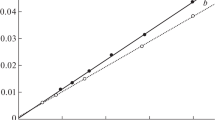Summary
Given the mobile and the stationary phase and values for the physical parameters such as temperature and pH, a separation can be optimized by varying the so-calledchromatographic parameters. These include the column dimensions, particle size, operating conditions (e.g. flow rate, attenuation) and instrumentation (e.g. detector cell, time constant). Optimization of the chromatographic parameters implies finding the best possible set of values, which we define as yielding (i) sufficient separation and (ii) sufficient sensitivity in (iii) the shortest possible time. Finding the best possible conditions (the global optimum) is very difficult for chromatographers in practice.
An expert system is described that allows chromatographic optimization to be performed for isocratic separations. An initial chromatogram is required to consult the system. In return, the system provides a complete set of chromatographic parameters, which represents the global optimum within the limits set by the required resolution and signal-to-noise ratio specified by the user. The tolerated flow and pressure ranges, the volume of the available detector cells and the time constant of the detection system are constraints during the optimization. A separate module of the system concerns the sample preparation for pharmaceutical formulations in solid dosages and aqueous solutions.
Prototype expert systems have been successfully implemented in the expert-system shell Knowledge Craft on a MicroVAX workstation.
Similar content being viewed by others
References
P. J. Schoenmakers, The optimization of chromatographic selectivity; A guide to method development, Elsevier, Amsterdam, 1986.
P. J. Naish, D. P. Goulder, C. V. Perkins, Chromatographia20, 335 (1985).
K. W. Freebairn, J. H. Knox, Chromatographia19, 37 (1984).
G. Guiochon inCs. Horváth, (ed.), High-performance liquid chromatography, Vol. 2, Academic Press, New York, 1980, pp. 1–56.
L. R. Snyder, J. W. Dolan, M. A. Quarry, Trends Anal. Chem.6, 106 (1987).
J. W. Dolan, L. W. Snyder, M. A. Quarry, Chromatographia24, 261 (1987).
P. J. Schoenmakers, J. K. Strasters, Á. Bartha, J. Chromatogr. accepted for publication.
Author information
Authors and Affiliations
Rights and permissions
About this article
Cite this article
Schoenmakers, P.J., Dunand, N., Cleland, A. et al. An expert system for the optimization of columns, operating conditions and instrumentation for high-pressure liquid chromatography. Chromatographia 26, 37–44 (1988). https://doi.org/10.1007/BF02268122
Received:
Accepted:
Issue Date:
DOI: https://doi.org/10.1007/BF02268122




